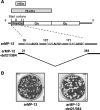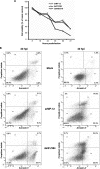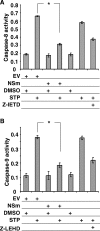NSm protein of Rift Valley fever virus suppresses virus-induced apoptosis
- PMID: 17913816
- PMCID: PMC2168885
- DOI: 10.1128/JVI.01238-07
NSm protein of Rift Valley fever virus suppresses virus-induced apoptosis
Abstract
Rift Valley fever virus (RVFV) is a member of the genus Phlebovirus within the family Bunyaviridae. It can cause severe epidemics among ruminants and fever, myalgia, a hemorrhagic syndrome, and/or encephalitis in humans. The RVFV M segment encodes the NSm and 78-kDa proteins and two major envelope proteins, Gn and Gc. The biological functions of the NSm and 78-kDa proteins are unknown; both proteins are dispensable for viral replication in cell cultures. To determine the biological functions of the NSm and 78-kDa proteins, we generated the mutant virus arMP-12-del21/384, carrying a large deletion in the pre-Gn region of the M segment. Neither NSm nor the 78-kDa protein was synthesized in arMP-12-del21/384-infected cells. Although arMP-12-del21/384 and its parental virus, arMP-12, showed similar growth kinetics and viral RNA and protein accumulation in infected cells, arMP-12-del21/384-infected cells induced extensive cell death and produced larger plaques than did arMP-12-infected cells. arMP-12-del21/384 replication triggered apoptosis, including the cleavage of caspase-3, the cleavage of its downstream substrate, poly(ADP-ribose) polymerase, and activation of the initiator caspases, caspase-8 and -9, earlier in infection than arMP-12. NSm expression in arMP-12-del21/384-infected cells suppressed the severity of caspase-3 activation. Further, NSm protein expression inhibited the staurosporine-induced activation of caspase-8 and -9, demonstrating that other viral proteins were dispensable for NSm's function in inhibiting apoptosis. RVFV NSm protein is the first identified Phlebovirus protein that has an antiapoptotic function.
Figures







Similar articles
-
Rift Valley fever virus NSs protein promotes post-transcriptional downregulation of protein kinase PKR and inhibits eIF2alpha phosphorylation.PLoS Pathog. 2009 Feb;5(2):e1000287. doi: 10.1371/journal.ppat.1000287. Epub 2009 Feb 6. PLoS Pathog. 2009. PMID: 19197350 Free PMC article.
-
NSm and 78-kilodalton proteins of Rift Valley fever virus are nonessential for viral replication in cell culture.J Virol. 2006 Aug;80(16):8274-8. doi: 10.1128/JVI.00476-06. J Virol. 2006. PMID: 16873285 Free PMC article.
-
Characterization of the Molecular Interactions That Govern the Packaging of Viral RNA Segments into Rift Valley Fever Phlebovirus Particles.J Virol. 2021 Jun 24;95(14):e0042921. doi: 10.1128/JVI.00429-21. Epub 2021 Jun 24. J Virol. 2021. PMID: 33952635 Free PMC article.
-
Rift Valley fever virus NSs protein functions and the similarity to other bunyavirus NSs proteins.Virol J. 2016 Jul 2;13:118. doi: 10.1186/s12985-016-0573-8. Virol J. 2016. PMID: 27368371 Free PMC article. Review.
-
[Rift Valley fever virus].Uirusu. 2004 Dec;54(2):229-35. doi: 10.2222/jsv.54.229. Uirusu. 2004. PMID: 15745161 Review. Japanese.
Cited by
-
Rapid accumulation of virulent rift valley Fever virus in mice from an attenuated virus carrying a single nucleotide substitution in the m RNA.PLoS One. 2010 Apr 1;5(4):e9986. doi: 10.1371/journal.pone.0009986. PLoS One. 2010. PMID: 20376320 Free PMC article.
-
Stable distinct core eukaryotic viromes in different mosquito species from Guadeloupe, using single mosquito viral metagenomics.Microbiome. 2019 Aug 28;7(1):121. doi: 10.1186/s40168-019-0734-2. Microbiome. 2019. PMID: 31462331 Free PMC article.
-
Human parainfluenza virus type 1 C proteins are nonessential proteins that inhibit the host interferon and apoptotic responses and are required for efficient replication in nonhuman primates.J Virol. 2008 Sep;82(18):8965-77. doi: 10.1128/JVI.00853-08. Epub 2008 Jul 9. J Virol. 2008. PMID: 18614629 Free PMC article.
-
Induction of caspase activation and cleavage of the viral nucleocapsid protein in different cell types during Crimean-Congo hemorrhagic fever virus infection.J Biol Chem. 2011 Feb 4;286(5):3227-34. doi: 10.1074/jbc.M110.149369. Epub 2010 Dec 1. J Biol Chem. 2011. PMID: 21123175 Free PMC article.
-
Rift Valley fever virus(Bunyaviridae: Phlebovirus): an update on pathogenesis, molecular epidemiology, vectors, diagnostics and prevention.Vet Res. 2010 Nov-Dec;41(6):61. doi: 10.1051/vetres/2010033. Vet Res. 2010. PMID: 21188836 Free PMC article.
References
-
- Aggarwal, B. B., W. J. Kohr, P. E. Hass, B. Moffat, S. A. Spencer, W. J. Henzel, T. S. Bringman, G. E. Nedwin, D. V. Goeddel, and R. N. Harkins. 1985. Human tumor necrosis factor. Production, purification, and characterization. J. Biol. Chem. 260:2345-2354. - PubMed
-
- Balkhy, H. H., and Z. A. Memish. 2003. Rift Valley fever: an uninvited zoonosis in the Arabian peninsula. Int. J. Antimicrob. Agents 21:153-157. - PubMed
Publication types
MeSH terms
Substances
Grants and funding
LinkOut - more resources
Full Text Sources
Other Literature Sources
Molecular Biology Databases
Research Materials
Miscellaneous

